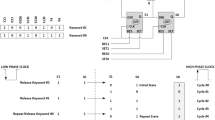Abstract
The linear feedback shift register (LFSR) based PN-sequence generator has found wide-ranging applications in network security, cryptography, compressive sensing, watermark, and so on. Therefore, in the literature, the PN sequences with different specifications have been introduced. Among them, the sequences with interleaved structure (time-multiplexed) have been widely used. However, most of the attentions have been paid to the length and speed of the PN-code-generator while the linear complexity (LC) while the statistic properties of the proposed sequences: have not been thoroughly discussed. In this paper, we will show that one needs to employ different effective tools to evaluate the performances of such sequences so that suitable sequences for application case can be correctly selected.
Access this chapter
Tax calculation will be finalised at checkout
Purchases are for personal use only
Similar content being viewed by others
References
G.M. Bhat et al., Field programmable gate array (FPGA) implementation of novel complex PN-code-generator-based data scrambler and descrambler. Maejo Int. J. Sci. Technol. 4(01), 125–135 (2010)
Q. Le Chi et al., A hardware oriented method to generate and evaluate nonlinear interleaved sequences with desired properties. J. Inform. Eng. Appl. 6(7), 1–12 (2016)
L.M. Hieu, L.C. Quynh, Design and analysis of sequences with interleaved structure by d-transform. IETE J. Res. 51(1), 61–67 (2005)
H.J. Zepernick, Pseudo Random Signal Processing Theory and Application (Wiley, 2005)
J. He, Interleaved Sequences Over Finite Field, Ph.D. Thesis Carleton University Ottawa, Ontario, 2013
J.M. Velazquez-Gutierrez et al, Sequence sets in wireless communication systems: a survey. IEEE Commun. Surv. Tutorials 19(2), 1225–1248 (2017)
V. Edemskiy, On the linear complexity of interleaved binary sequences of period 4p obtained from Hall sequences or Legendre and Hall sequences. Electron. Lett. 50(8), 604–605 (2014)
C. Ding, Codes From Difference Sets (World Sci, Hackensack, NJ, USA, 2015)
P. Xia, S. Zhou, G.B. Giannakis, Achieving the Welch bound with difference sets. IEEE Trans. Inf. Theor. 51(5), 1900–1907 (2005)
Q.L. Chi, K.T. Vu et al, FPGA Implementation of Optimal PN Sequences by Time_Multiplexing Technique. Springer Nature Switzerland AG 2020 K.-U. (Eds.): ICERA 2019, LNNS 104, pp. 373–380 (2020)
S.W. Golomb, G. Gong, Signal Design for Good Correlation—For Wireless Communication, Cryptography, and Radar
L. Wang et al, A random sequence generation method for random demodulation based compressive sampling system. Int. J. Signal Process. Image Process. Pattern Recogn. 8(1), 105–114 (2015)
N. Wang et al, Physical-layer security in internet of things based on compressed sensing and frequency selection. IET Commun. 11(9), 1431–1437 (2017)
J. Yoo et al, Design and Implementation of a Fully Integrated Compressed—Sensing Signal Acquisition System (California Institute of Technology, 2012), pp. 1–4
W. Liu et al, Researches on the wideband spectrum sensing prototype system based on MWC. Int. J. Sig. Process. Syst. 5(2), 70–74 (2017)
X. Chen, Sub-Nyquist Rate Sampling Data Acquisition Systems Based on Compressive Sensing, Ph.D. Dissertation Texas A&M University, May 2011
J.N. Laska et al., Theory and Implementation of an Analog-to-Information Converter using Random Demodulation (Rice University, Houston, Texas, 2014)
J. Kufel et al, Sequence-aware watermark design for soft IP embedded processors. IEEE Trans. Very Large Scale Integr. (VLSI) Syst. 1–14 (2015)
M. Li, PN-sequence masked spread-spectrum data embedding, in IEEE/CIC ICCC 2015 Symposium on Privacy and Security in Communications, pp 1–6
Author information
Authors and Affiliations
Corresponding author
Editor information
Editors and Affiliations
Rights and permissions
Copyright information
© 2021 The Editor(s) (if applicable) and The Author(s), under exclusive license to Springer Nature Singapore Pte Ltd.
About this paper
Cite this paper
Nguyen, L.C., Tran, V.K., Le, C.Q. (2021). On the Desired Properties of Linear Feedback Shift Register (LFSR) Based High-Speed PN-Sequence-Generator. In: Joshi, A., Khosravy, M., Gupta, N. (eds) Machine Learning for Predictive Analysis. Lecture Notes in Networks and Systems, vol 141. Springer, Singapore. https://doi.org/10.1007/978-981-15-7106-0_19
Download citation
DOI: https://doi.org/10.1007/978-981-15-7106-0_19
Published:
Publisher Name: Springer, Singapore
Print ISBN: 978-981-15-7105-3
Online ISBN: 978-981-15-7106-0
eBook Packages: Intelligent Technologies and RoboticsIntelligent Technologies and Robotics (R0)




